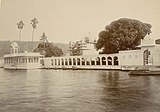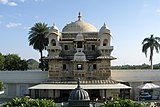Jag Mandir Palace
| Jag Mandir | |
|---|---|
 Jag Mandir with sculpture of eight elephants adorning the entrance and facing the Lake Palace | |
 | |
| General information | |
| Architectural style | Rajput architecture |
| Town or city | Udaipur |
| Country | India |
| Coordinates | 24°34′02″N 73°40′41″E / 24.5672°N 73.6781°E |
| Construction started | 1551 |
| Completed | Mid 17th century |
| Client | Maharana Jagat Singh I |
| Owner | Arvind Singh Mewar |
| Technical details | |
| Structural system | Yellow Sandstone and Marble |
Jag Mandir is a palace built on an island in the
Geography
Jag Mandir is situated in one of the two natural islands in the Pichola lake (named after the village Picholi nearby), on its southern end. The lake was initially created in the 15th century by a local banjara tribal chieftain for carrying grain across the streams. During the reign of Maharana Udai Singh II, in 1560, the lake was substantially enlarged by constructing dams across two streams. At that time, the Maharana also built the Jag Mandir and the Lake Palace (Jag Niwas Hotel) on islands in the midst of the lake. Udaipur city with its City Palace and other monuments and temples were built on the periphery of the lake.[7][8]
History

The real threat, which almost decimated Mewar kingdom for many years, came from the marauding
During the revolt in 1857, Maharana Swroop Singh (1842–1861) saved a number of European families, mostly women and children from
After the
Structure


The impressive series of structures in the three-storied Jag Mandir Palace include:
- Gul Mahal, which was built first as refuge for prince Khurram;
- the elegant facade flanked by four carved statues of elephants on either side at the jetty entry on the lake from Udaipur;
- the Garden Courtyard and the Darikhana on its northern side;
- Bara Patharon ka Mahal (palace of the 12 stones);
- the Zenana Mahal – a southern extension to the Gul Mahal;
- and the Kunwar Pada ka Mahal.[1][4]
Details of these structures and of the garden are elaborated below.
- Gul Mahal
Gul Mahal was the first structure built in 1551, during the reign of Maharana Amar Singh, which was further developed during the reign of Maharana Jagat Singh to house the Mughal Prince Khurram. It was initially a small sandstone (yellow sandstone) palace with an imposing dome (which gives the appearance of a crown). The
- Jag Mandir
Jag Mandir is the main palace, which incorporates the Gul Mahal. The towers of the palace at the corners are octagonal in shape and are topped with
- Entry pavilion
The pavilion at the entry to the palace is an impressive white colonnade of cusped arches. The landing jetty is also located for docking of boats arriving from the jetty of Bansi Ghat on the mainland near City Palace in Udaipur. The cruise is through the Pichola Lake. The pavilion is decorated with large elephants carved in stone, four on each side of the entry steps. They face the Lake Palace. The trunks of these elephants were damaged and replaced with
- Garden
The flower garden in the palace complex is set up in the large Garden Courtyard. It has
- Darikhana
Darikhana is on the northern side of the palace, which is an open-sided terrace built with marble columns. This place is now run as a restaurant by the present Maharana.[1]
- Bara Patharon ka Mahal
Bara Patharon ka Mahal is located at the eastern wing of the main palace. Mahal is so named because twelve solid marble slabs have been used in its construction.[1] Hence, it is also known as the "Palace of the Twelve Stones".[1]
Visitor information
The Jag Mandir is approached only by boat from the Bansi Ghat jetty next to the Lake Palace in Udaipur.
In popular culture
The 1983 James Bond film, Octopussy featured the Jag Mandir as one of its main locations.
Gallery
-
An aerial view of Jag Mandir
-
Engraving of the Jag Mandir palace, 1829
-
Full View of Island palace Jagmandir, 1910
-
Closer view of the Jagmandir with the Gul Mahal at the back
-
Jag Mandir Palace from above, on Lake Pichola, Udaipur.
-
Gul Mahal, Jag Mandir Palace.
See also
References
- ^ a b c d e f g h i j k l m "Jag Mandir". Eternal Mewar: Mewar Encyclopedia. Archived from the original on 21 July 2011. Retrieved 16 December 2009.
- ^ a b "Palace of Jugmundur in Oodipoor Lake". British Library Online Gallery. Retrieved 16 December 2009.
- ^ "Jag Mandir Palace". Retrieved 16 December 2009.
- ^ )
- ^ "Jagmandir Palace, Udaipur". Archived from the original on 16 June 2009. Retrieved 16 December 2009.
- ^ )
- ^ "Lake Pichola". National Informatics Centre. Archived from the original on 27 March 2013. Retrieved 16 December 2009.
- ^ "Pichola Lake". Eternal Mewar: Mewar Encyclopedia. Archived from the original on 21 July 2011. Retrieved 16 December 2009.
- ^ )
- ^ "Pichola lake and island of Jagmandir, Udaipur. 'Decr. 1878'". British Library Online Gallery. Retrieved 16 December 2009.
- ^ "Jugmandir Water Palace, [Udaipur]". British Library Online Gallery. Retrieved 16 December 2009.
- ^ "Island palace Jagmandir, Udaipur 101214". British Library Online Gallery. Retrieved 16 December 2009.






